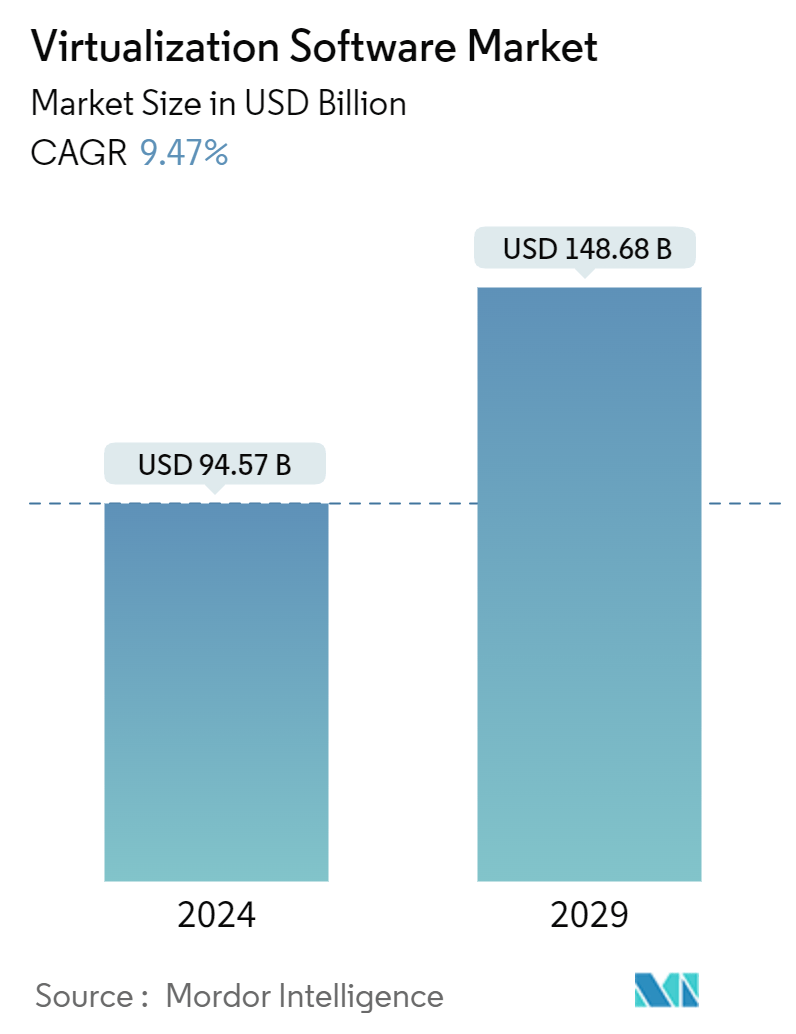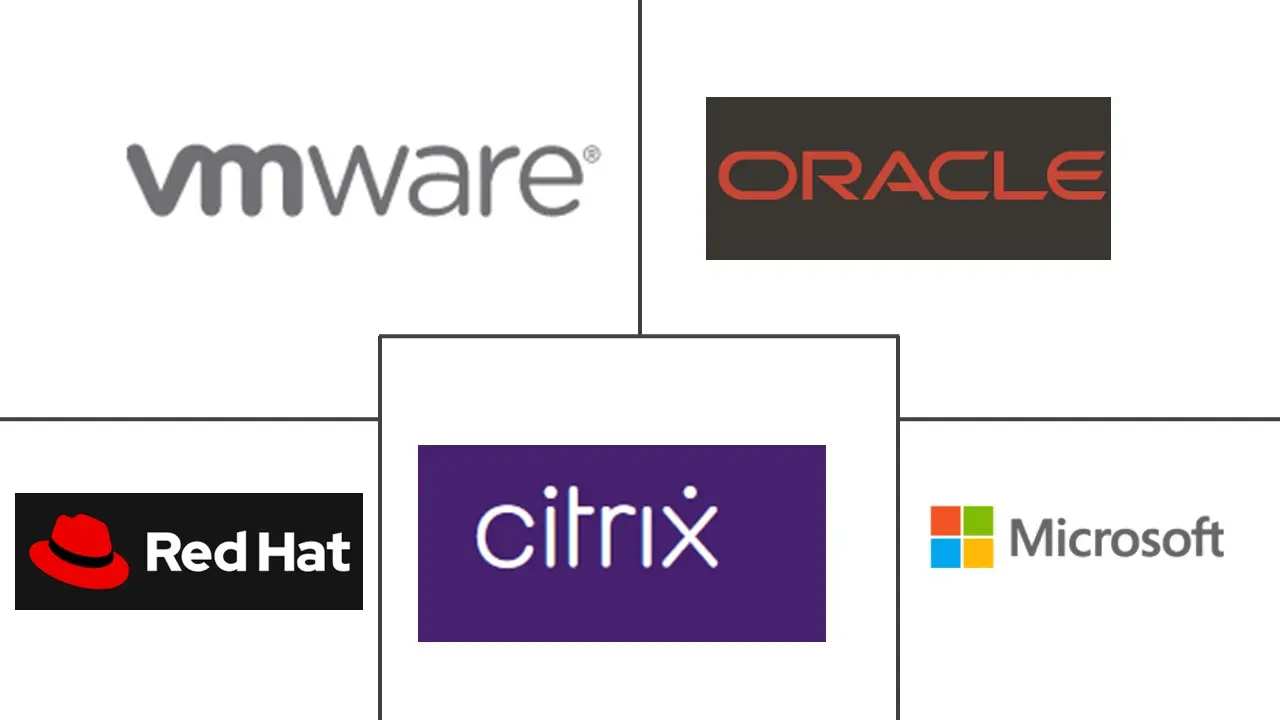Market Size of Virtualization Software Industry

| Study Period | 2019 - 2029 |
| Market Size (2024) | USD 94.57 Billion |
| Market Size (2029) | USD 148.68 Billion |
| CAGR (2024 - 2029) | 9.47 % |
| Fastest Growing Market | Asia Pacific |
| Largest Market | North America |
| Market Concentration | Low |
Major Players
*Disclaimer: Major Players sorted in no particular order |
Virtualization Software Market Analysis
The Virtualization Software Market size is estimated at USD 94.57 billion in 2024, and is expected to reach USD 148.68 billion by 2029, growing at a CAGR of 9.47% during the forecast period (2024-2029).
The virtualization software market is a pivotal component of modern IT infrastructure, enabling businesses to optimize resource utilization, streamline management processes, and reduce operational costs. Virtualization software abstracts hardware systems, allowing multiple virtual environments to operate on a single physical machine. This decoupling of hardware from software facilitates the creation of virtual machines (VMs), which emulate physical computers, enhancing flexibility for applications such as server virtualization, cloud computing, and disaster recovery. As organizations increasingly adopt data center virtualization and cloud-based services to meet rising computational demands, the virtualization software market continues to expand.
- Efficiency through Virtualization: Virtualization technologies offer significant efficiency improvements, enabling IT departments to deploy resources quickly and scale infrastructure as needed. Businesses benefit from centralized management and enhanced virtualization security. Open-source virtualization software provides cost-effective solutions, while proprietary platforms offer comprehensive features and dedicated support. However, successful implementation of virtualization often requires specialized expertise for setup and configuration, particularly in complex environments.
- Key Industry Players: Major players such as VMware, Microsoft, Citrix Systems, and Oracle are leading innovation in this field. These companies are focused on developing virtualization platforms that support server virtualization, network virtualization, desktop virtualization, and cloud-native virtualization. To stay competitive, these market leaders invest in enhancing hypervisor technology, improving automation, and integrating robust security features.
IT Infrastructure Optimization through Virtualization
- Cost Reduction: Virtualization helps businesses reduce operational expenses by minimizing the need for additional hardware. With server virtualization, multiple virtual machines run on a single server, optimizing hardware utilization and cutting costs associated with purchasing and maintaining physical servers.
- Hardware Savings: Traditional IT environments require separate physical servers for different operating systems, leading to hardware underutilization. By virtualizing these systems, companies achieve higher server utilization rates, reducing the overall number of physical machines required. This contributes to reduced capital expenditures on hardware and lower energy consumption.
- Scalability: Virtualization software enables rapid scaling of IT infrastructure. Businesses can quickly create, clone, or migrate virtual machines with minimal downtime, allowing them to respond to fluctuating demand in cloud environments or high-performance computing scenarios.
- Energy Efficiency: Consolidating physical servers leads to fewer energy requirements for power and cooling, enhancing the energy efficiency of data centers. This not only lowers operational costs but also supports corporate sustainability efforts by reducing the organization’s carbon footprint.
Streamlining IT Operations with Virtualization
Virtualization technology dramatically simplifies IT management by allowing teams to centrally manage virtual environments. The ability to deploy virtual machines quickly and troubleshoot issues through a single platform enhances operational efficiency.
- Centralized Management: Virtual machine management is simplified through centralized control offered by virtualization platforms. IT administrators can deploy, update, and manage multiple virtual environments from a single interface, reducing complexity and minimizing the time spent on maintenance.
- Disaster Recovery: Virtualization solutions enhance disaster recovery strategies. Virtual machines can be easily backed up and restored, significantly improving recovery times in case of system failure. Moreover, many virtualization platforms incorporate disaster recovery tools, reducing reliance on third-party solutions.
- Enhanced Security: Virtualization enables the isolation of virtual machines, reducing the risk of security breaches. With virtualization security features like role-based access control, encryption, and secure migration, businesses can safeguard sensitive data and limit the impact of potential attacks.
Virtualization Software Industry Segmentation
Virtualization Software, also called a Hypervisor, allows two or more operating systems (OSs) to run on a single host machine or server. The software can run on a machine without OS (Type 1) or on top of an OS (Type 2). It allows the virtualization of components, like hardware, OS, network, or storage. The study covers the market based on the platform on which the software OS is hosted, and the type of virtualization software available across the globe.
The virtualization software market is segmented by platform (PC virtualization and mobile virtualization), by type (application virtualization, network virtualization, and hardware virtualization), and by geography (North America, Europe, Asia Pacific, Latin America, and Middle East and Africa). The report offers market forecasts and size in value (USD) for all the above segments.
| By Platform | |
| PC Virtualization | |
| Mobile Virtualization |
| By Type | |
| Application Virtualization | |
| Network Virtualization | |
| Hardware Virtualization | |
| Other Types |
| By Geography*** | |
| North America | |
| Europe | |
| Asia | |
| Australia and New Zealand | |
| Latin America | |
| Middle East and Africa |
Virtualization Software Market Size Summary
The Virtualization Software Market is poised for significant growth, driven by the increasing need for efficient IT resource utilization and flexibility. Virtualization technology, which decouples operating systems from physical hardware, allows multiple virtual machines to run in isolation on the same physical machine. This capability is becoming increasingly important as organizations seek to optimize their IT infrastructure and reduce costs. The market is experiencing a surge in demand due to the rapid advancements in telecommunications, cloud computing, and IoT, which are pushing companies to enhance their digital offerings. The Asia-Pacific region is expected to lead in adoption, fueled by the growing acceptance of virtual desktop infrastructure and software virtualization platforms in large IT companies. The rise of cloud-based solutions and the need for secure data storage are also key factors driving market expansion.
The market is characterized by a fragmented landscape with numerous major players, including VMware Inc, Citrix Systems Inc., Oracle Corporation, Microsoft Corporation, and Red Hat Inc. These companies are actively engaging in strategic partnerships, mergers, and collaborations to strengthen their market positions. The COVID-19 pandemic has further accelerated the adoption of virtualization solutions as companies shift towards remote work models, increasing the demand for secure and efficient remote work capabilities. The healthcare sector, in particular, is witnessing a growing demand for PC virtualization amid digital transformations. As organizations continue to embrace cloud computing and virtualized infrastructures, the market is expected to see substantial growth, with significant investments and technological advancements paving the way for future opportunities.
Virtualization Software Market Size - Table of Contents
-
1. MARKET INSIGHTS
-
1.1 Market Overview
-
1.2 Industry Attractiveness - Porter's Five Forces Analysis
-
1.2.1 Bargaining Power of Suppliers
-
1.2.2 Bargaining Power of Consumers
-
1.2.3 Threat of New Entrants
-
1.2.4 Intensity of Competitive Rivalry
-
1.2.5 Threat of Substitutes
-
-
1.3 Assessment of Impact Of Covid-19 on the Industry
-
-
2. MARKET SEGMENTATION
-
2.1 By Platform
-
2.1.1 PC Virtualization
-
2.1.2 Mobile Virtualization
-
-
2.2 By Type
-
2.2.1 Application Virtualization
-
2.2.2 Network Virtualization
-
2.2.3 Hardware Virtualization
-
2.2.4 Other Types
-
-
2.3 By Geography***
-
2.3.1 North America
-
2.3.2 Europe
-
2.3.3 Asia
-
2.3.4 Australia and New Zealand
-
2.3.5 Latin America
-
2.3.6 Middle East and Africa
-
-
Virtualization Software Market Size FAQs
How big is the Virtualization Software Market?
The Virtualization Software Market size is expected to reach USD 94.57 billion in 2024 and grow at a CAGR of 9.47% to reach USD 148.68 billion by 2029.
What is the current Virtualization Software Market size?
In 2024, the Virtualization Software Market size is expected to reach USD 94.57 billion.

